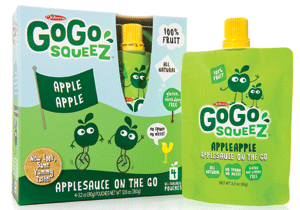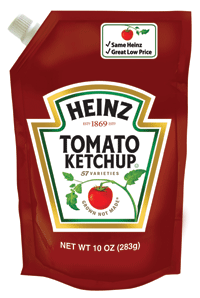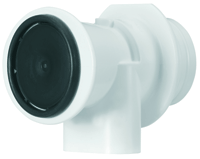Stand Up and Spout
PACKAGING
As with so many food packaging innovations, spouted stand-up flexible pouches led by the squeezable baby fruit sauce packages edged into our collective consciousnesses only a few months ago. Now, when we observe the retail food scene, we see ketchup, mayonnaise, wine, salsa, honey, juice, premixed cocktails, and a host of fluid food products in stand-up flexible pouches complemented with plastic dispensing devices.
These intriguing structures represent a tribute to the basic premise that food and food packaging ride a continuum. The origins were in the mid-1960s with the classical Doypak stand-up flexible pouch introduced to ultra cost-sensitive consumer packaged goods marketers, who flinched. A scant few stand-up flexible structures were applied for single-serve beverages. One example is Capri Sun, which competed in the 1970s with aseptic paperboard composite brick packs. Cut to the 1990s, and stand-up flexible pouches, by now perceived as cost-saving, suddenly began replacing bag-in-box and paperboard cartons for flowable dry foods (e.g., cookies, candies, and dried fruit).
Meanwhile, throughout this time frame, paperboard cartons and plastic bottles gradually replaced their metal closures and pouring spouts (awkward, almost nonfunctional, and hazardous to the finger), with injection-molded plastic formats that proved difficult to affix but reasonably consumer-convenient when they functioned.
And then came a daring marriage of rigid plastic dispenser with stand-up flexible pouch from Hosakawa in Japan with its Cheer Pak (www.cheerpack.com), which became a niche package for kids’ drinks offshore—a perfect storm intersection of history with innovation.
 The Genealogy of Spouted Stand-up Flexible Pouches
The Genealogy of Spouted Stand-up Flexible Pouches
Fascinated with the several spouted flexible stand-up pouches that had spilled almost silently onto the fluid food market in 2011 and 2012, graduate student Meredith Hill ([email protected]) plunged into the emergent scene with her final secondary research project for the University of Georgia Master in Food Technology program. (For more information on this advanced degree curriculum, contact [email protected].)
This information is taken directly from Ms. Hill’s comprehensive view of the chronology, status, and future for a food packaging innovation whose components have been in clear view for more than a score of years, but was grabbed by bold marketers only in this decade.
Ms. Hill’s research, which describes the advantages and disadvantages of stand-up flexible pouches with dispensing fitments, is rooted in the discrepancy of several disparate effective technologies that were for so long invisible to those who needed it so much.
Food packaging has evolved to aggressively assume a more active role to assist consumer packaged goods companies in differentiating their products in the marketplace. Various materials, shapes, structures, and functionalities have been applied to making a product package stand out amidst the noise of the competitive environment. With two-thirds of consumer purchasing decisions being made in the retail aisle, enticing and functional packaging is more important than ever in a food product’s success or failure.
Flexible Package Materials
The flexible package not only protects the food contents, but can also be manipulated to accommodate tight spaces for consumers packing the product on the go and/or finding room for it in the refrigerator, freezer, pocket, purse, or pantry. Flexible pouches containing the same volume of product as rigid or semi-rigid containers are not as bulky on the retail shelf, making more space available. The flexible package unit weighs less and occupies less space on distribution vehicles, which translates into lower distribution cost per product unit.
Stand-up Feature
 The stand-up aspect of the stand-up flexible pouch is achieved by adding a bottom, side, or top gusset. A gusset is a fold in the sides, bottom, or top of a pouch that allows it to expand when filled. The weight of the product coupled with the expansion of the pouch is the mechanism by which stand-up aspect is achieved.
The stand-up aspect of the stand-up flexible pouch is achieved by adding a bottom, side, or top gusset. A gusset is a fold in the sides, bottom, or top of a pouch that allows it to expand when filled. The weight of the product coupled with the expansion of the pouch is the mechanism by which stand-up aspect is achieved.
Three categories of gussets are in use today: bottom, side, and top. Bottom gussets may be round, K-style, and plow. The round bottom gusset is applied for products weighing less than one pound, and is the most common type in food packaging.
The K-style is designed for heavier products since the seals on both sides rise from the pouch at 30 degree angles, which eases pressure off the seals on the front and back sides, thus allowing for additional volume.
The plow style is also known as a corner seal. It is made from one piece of film and therefore does not have a seal at the gusset as do the round and K-style types. Instead it has two corner seals and relies on the weight of the food product to “plow” down and the pouch to stand on the shelf. This style is mainly used for products weighing more than one pound due to its stability. It is often chosen for larger packaging of granular substances and liquids.
The side gusset pouch has gussets on either side of the package rather than on the bottom. Side gusset pouches accommodate expansion of the package when filled with product, allowing the weight of the product to provide the stand-up function. The major differences are that the bottom is flat and more balanced, and the pouch now has five sides instead of three.
The stand-up feature is important to marketers since it can provide good shelf visibility. The packages are so lightweight, however, that they can fall more easily than their rigid and semi-rigid counterparts, thus impairing their shelf visibility. A “fix” for this is to unitize the pouches in their own display cartons on the shelf. A display can be included in the secondary package with the product, which will cut into already thin margins for packagers and retailers.
--- PAGE BREAK ---
Fitments Fit the New Need
Dispensing fitments and caps are most often injection molded from polypropylene (PP), low density polyethylene (LDPE), or high density polyethylene (HDPE). These materials are all lightweight, tough, low-cost, and well suited for the injection molding process employed to produce the fitments.
 The hundreds of different spout/cap fitments may be classified into seven main types.
The hundreds of different spout/cap fitments may be classified into seven main types.
• Basic spout with screw cap. Whether corner or top placement, the basic spout featuring reclosability has a twist-off screw cap. It can be used as a filling nozzle for the product since the cap can be installed after the filling process.
• Extended spout (sometimes referred to as a straw) with cap. The extension functions as a straw, allowing the consumer to dispense the product while keeping the pouch upright. For low-viscosity liquids, this also allows the same type of added control as using a straw as opposed to drinking out of a cup.
• Child choke hazard safety feature cap. The U.S. Consumer Product Safety Commission requires that an object be larger than the dimensions of the small-parts test fixture (SPTF) to qualify as safe. SPTF is a truncated cylinder with a diameter of 1.25 in, simulating the mouth, and a depth between 1 in and 2.25 in, simulating the pharynx. An object is considered a small part if it fits completely within the SPTF. An additional safety feature of these fitments is the vent, which would allow air to flow even if swallowed.
• Hanging cap. With this type, a retailer can rack the product for display.
• Narrow tip. This type allows for better control than a wide tip and is therefore appropriate for deliberate expulsion of product, such as with decorator icing.
• Sports cap. This is a pull-push cap for water and sports drinks. A narrowed opening permits the user to squirt the liquid into the mouth.
• Top cap. This cap is more environmentally friendly since the cap stays attached to the fitment, and it is also convenient for the consumer.
Variations include different diameters, colors, and/or shapes. Diameter differentiations are generally for the purpose of delivering desired flow rates.
While the tops of fitments can vary, the bottom part of the fitment must be of the “canoe” style when sealed between two layers of film. The canoe shape is an attempt to minimize the stress of change in the direction of pouch material as it contacts the fitment and thus improve the integrity of the joint where the two sides of the pouch come together, in this way promoting a more reliable seal.
Much less common is the front spout. This type does not use the canoe style, but rather a gland to anchor the fitment to the package. One difference is that a gland is welded to one piece of film instead of in the seam of two pieces and therefore does not have the “canoe” shape.
Food Processing
Hot fill is the most common method of filling stand-up flexible pouches with high-acid fluid products such as applesauce and juices. It allows the heat of the treated food product to sterilize the pouch as it is being filled. The filled and capped pouch is cooled to arrest the heating process. Not yet universal is retorting, post-fill thermal sterilization treatment with elevated pressure for low-acid food products such as soups, sauces, dairy products, and low-acid baby food. The flexible pouch and fitment materials must possess heat resistance above the highest temperature encountered while the food product is being commercially sterilized.
Aseptic is a process in which the food product is thermally treated and then filled in a previously sterilized pouch with a fitment that has also been sterilized. Aseptic packaging can be used for both high- and low-acid products such as dairy-based drinks, sport drinks, fruit juices, drinkable yogurts, beverages, and more viscous low-acid foods such as soups or sauces. Aseptic fitments for aseptic packages have been developed to permit the dispenser to be opened and reclosed many times (www.idcdispensing.com).
Filling Operations
Introducing fluid contents into spouted stand-up flexible pouches can be accomplished by several different mechanisms. In traditional methodology, the content is pumped into the spout, which has been previously affixed to the pouch. A more recent technology seals the fitment to an upper corner of the pouch, leaving a top opening in the flexible pouch through which the fluid is pumped or flowed, after which the opening is heat sealed. Yet another method is to fill through the top opening of the pouch after which the fitment is affixed and the entire assembly is sealed shut.
Looking Forward
The evolution of package materials, equipment, and fitments should improve cost, safety, quality, and functionality for both manufacturers and consumers. No packaging is perfect, and stand-up flexible pouches with dispensing fitments certainly have hurdles in seal integrity, output speeds, cost of capital equipment, and consumer acceptance areas. However, they have upsides as well, such as being lightweight, often reclosable, fabricated from protective barrier films, and conducive to the trend of convenience products that today’s on-the-go lifestyles require. The spent packages occupy less landfill volume than other packaging options.
Also, with baby food and children’s fruit snacks leading growth in the category of stand-up flexible pouches with dispensing fitments, future generations are being exposed to this type of packaging at a young age and are more likely to accept, and even expect, food products to be packaged in this manner as today’s youths age.
 Aaron L. Brody, Ph.D., Contributing Editor
Aaron L. Brody, Ph.D., Contributing Editor
President and CEO, Packaging/Brody Inc.,
Duluth, Ga., and Adjunct Professor,
University of Georgia
[email protected]
